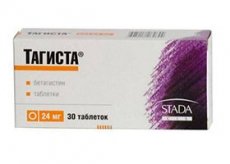Medical expert of the article
New publications
Preparations
Tagist
Last reviewed: 23.04.2024

All iLive content is medically reviewed or fact checked to ensure as much factual accuracy as possible.
We have strict sourcing guidelines and only link to reputable media sites, academic research institutions and, whenever possible, medically peer reviewed studies. Note that the numbers in parentheses ([1], [2], etc.) are clickable links to these studies.
If you feel that any of our content is inaccurate, out-of-date, or otherwise questionable, please select it and press Ctrl + Enter.

Active active substance - Betahistinum (betagistin)
Producer: firm "Makiz Pharma", Russia
Pharmacological action is aimed at improving microcirculation of blood circulation.
Indications of the tagist
Can be appointed by a doctor at: occurrence of "ringing" in the ears; labyrinthites; persistent reduction and loss of hearing; atherosclerosis of cerebral vessels; vertebrobasilar insufficiency; traumatic encephalopathy; inflammation of the vestibular nerve; dizziness after neurosurgical operations.
Tablets have a flat-cylindrical shape. The color is cream or white, with a cross bar for convenient division.
- 10 pieces. - in the blister (3, 5), which is stored in a cardboard bag.
- 30 pcs. - in blisters (1, 2, 3), which are stored in a cardboard bag.
- 30 pcs. - in a plastic can (1), which is placed in a cardboard bag.
 [1]
[1]
Release form
Each tablet may contain a different amount of betahistine dihydrochloride: 8; 16 or 24 mg. Tagista is sold with a prescription.
Analogues:
- Stugeron
- Cinnarizine
Pharmacodynamics
Betagistin is a structural analogue of endogenous histamine. It is a strong antagonist of histamine H3 receptors. Initially, it was believed that the action of betagistin is responsible for stimulating H1 receptors in the blood vessels of the inner ear and local expansion and increasing the permeability of these vessels. However, the effect on H1 receptors was negligible. After binding to the H3 receptor, it eliminates the inhibitory effect of histamine and increases the release of neurotransmitters. The amount of histamine released increases and stimulates H1 receptors, following the expansion of the blood vessels of the inner ear.
In addition, betagistin increases the level of neurotransmitters, such as, serotonin in the brain, which in turn inhibits the vestibular nucleus, thereby preventing vertigo (vestibular and vertigo disorders).
Betagistin increases the permeability of the pulmonary epithelium, and has a positive inotropic effect.
Pharmacokinetics
The active substance is rapidly absorbed along the entire length of the gastrointestinal tract and practically does not bind to plasma proteins. After one hundred and eighty minutes, the highest concentration of the drug in the blood is reached. Tagista is excreted from the body with urine within 24 hours.
 [4],
[4],
Dosing and administration
The drug Taghista is administered orally and taken with food.
Tablets are taken as follows with a mass of betagistina 8 mg - three single-dose per day for 1-2 tablets; 16 mg - for a day in three doses, and 24 mg - for 1 tablet of two single admission.
In general, the improvement is already noticeable in the initial stage of treatment. A strong therapeutic effect is achieved by the end of the second week of therapy. Perhaps a rise in a few months. Duration of treatment is determined by the doctor individually, but the standard course of therapy takes quite a long time.
 [7]
[7]
Use of the tagist during pregnancy
It is not desirable to use the drug when breastfeeding and pregnant. It is not known whether it can accumulate in the mother's milk. The restriction is also the age of 18 years because of the lack of data on safe and effective use.
Contraindications
- individual intolerance to digiboride betaagistine or excipients;
- diseases of the duodenum and stomach;
- rare hereditary problems with intolerance to galactose, deficiency of lactase, malabsorption of glucose-galactose, since the drug contains lactose);
- problems with breathing (attacks of bronchial asthma);
- malignant neoplasms of the adrenal glands (including pheochromocytoma).
 [5]
[5]
Side effects of the tagist
Among the negative effects of the drug, most often on the part of the digestive system, there are attacks of nausea, vomiting; allergic manifestations - itchy skin, hives, rashes, in addition, there are cases of the development of edema Quincke, headache, palpitations. When there is drowsiness, it is necessary to abandon the management of any vehicle.
These symptoms usually disappear when the drug is taken with food or reduce the dose. If any of these side effects occur, you should notify the doctor immediately.
 [6]
[6]
Overdose
In case of an overdose of Taghist, nausea and vomiting may occur, and convulsions may occur. It is necessary to carry out symptomatic therapy, including with washing the stomach and taking activated charcoal. In case of an overdose, it is necessary to contact the doctor immediately to correct the treatment regimen.
Storage conditions
- Storage should be carried out in the original packaging in order to protect from sunlight and moisture;
- The optimum storage temperature should not exceed 30 ° C
- It is not recommended to use the medicine after the expiry date indicated on the package;
- It is not recommended to be disposed of in sewerage or household waste.
- Keep away from children

Shelf life
It is 36 months (three years). The date of manufacture and expiry date are displayed on the packaging.

Attention!
To simplify the perception of information, this instruction for use of the drug "Tagist" translated and presented in a special form on the basis of the official instructions for medical use of the drug. Before use read the annotation that came directly to medicines.
Description provided for informational purposes and is not a guide to self-healing. The need for this drug, the purpose of the treatment regimen, methods and dose of the drug is determined solely by the attending physician. Self-medication is dangerous for your health.

